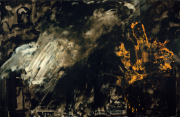Abstract
This article examines Andrea di Bonaiuto’s image of Averroes in the Triumph of St Thomas Aquinas (Spanish Chapel, Florence: 1365–69), explored alongside Bonaiuto’s primary visual source, Lippo Memmi’s panel painting, Triumph of St Thomas Aquinas (Pisa, c. 1323–30), and Dante’s Commedia. I argue that Bonaiuto’s iconography, developed within a Dominican context, is unique to the Spanish Chapel Triumph because it propagates Averroes as both a heterodox philosopher and a heretical Muslim precisely at a time when the Arab philosopher was acclaimed as the Great Commentator. Through comparative analysis, I demonstrate that Bonaiuto makes significant modifications to Memmi’s Triumph, the panel painting which first establishes an Aquinas-Averroes iconographic formula created to uphold the orthodoxy of Thomistic Aristotelianism by casting Averroes into a contemptible position, a formula also utilised by Benozzo Gozzoli in a later Triumph of St Thomas Aquinas (Pisa, c. 1470–75). I argue that Memmi’s image of Averroes can be read as a Dominican comment on the heterodoxy of Arabic Aristotelianism in spite of its widespread reception into Latin scholasticism. This feature is further developed by Bonaiuto who presents Averroes as an indolent philosopher and in a departure from Memmi’s formula, as a heretical Muslim. Such a reading is further elucidated when Bonaiuto’s Triumph is considered alongside Dante’s literary treatment of Arabic philosophers, the Prophet Muhammad, and Christian heresy in the Commedia, ultimately revealing that the reception of Arabic philosophers is entangled with Islam in a far more complex and ambiguous manner than once considered.
Except where otherwise noted, the content of this site is licensed under a Creative Commons Attribution-ShareAlike 4.0 International (CC BY-SA 4.0).
Authors retain copyright of their work. The CC BY-SA 4.0 licence allows readers to copy and redistribute the material in any medium or format, and to remix, transform, and build upon the material for any purpose, even commercially, as long as the original author is credited and as long as any works that are derived from the original are distributed under the same terms.

